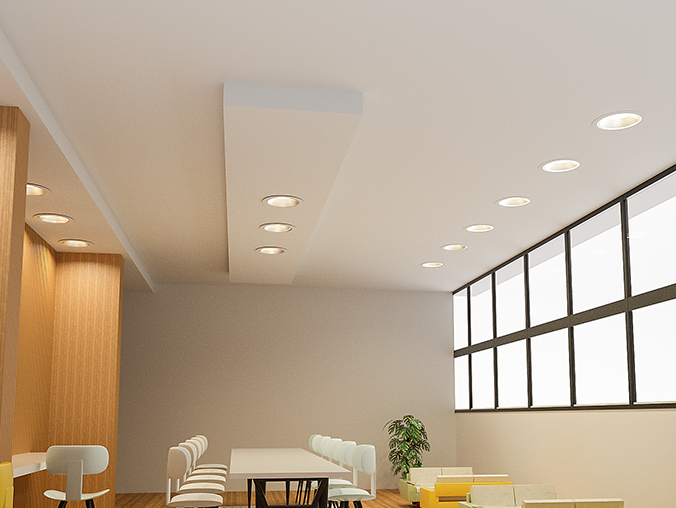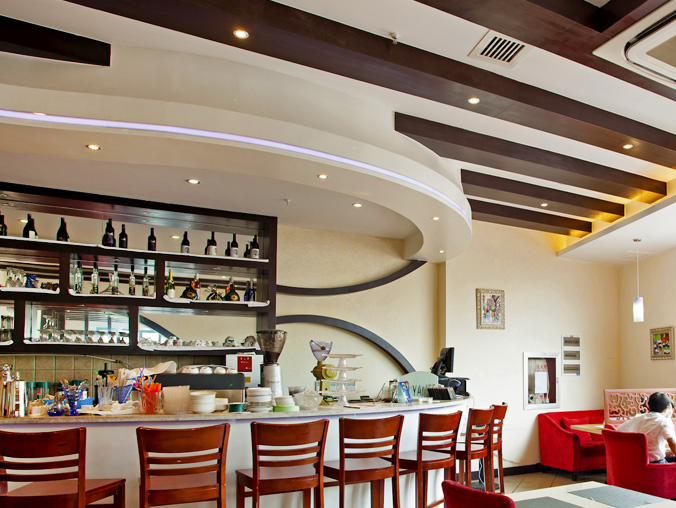

downlight ceiling design plays a key role in creating spatial layering by using light to distinguish zones, highlight focal points, and add depth to a room. Through strategic placement, brightness control, and fixture selection, it transforms flat spaces into multi-dimensional areas. IMIGY Lighting’s Grace Down Lights (a dimmable downlight led) and Phoenix Down Lights (compatible with down panel light setups) are designed to maximize this effect, making spaces feel more dynamic. The following explains how.
1. Zone Differentiation with Light Intensity
a. Task Zones vs. Ambient Areas
downlight ceiling design uses varying brightness to separate functional zones. In living rooms, Grace Down Lights (a downlight 5 inch model) focused over sofas (task zones) shine brighter (80-100%), while Phoenix Down Lights in surrounding areas (ambient zones) dim to 30-50%. This contrast defines spaces without physical dividers, enhancing layering in open layouts.
b. Open-Concept Space Segregation
In combined living-dining areas, down panel lights paired with Phoenix Down Lights create subtle boundaries. Dining zones use warmer light (3000K) from the panels, while living areas use cooler Grace Down Lights (4000K). This color-temperature layering, part of smart downlight ceiling design, differentiates zones seamlessly.
2. Focal Point Highlighting
a. Accentuating Decor or Artwork
downlight ceiling design directs light to focal points—e.g., a painting or bookshelf—using Grace Down Lights (dimmable downlight leds) angled precisely. Dimming surrounding down light ceiling fixtures (to 20-40%) makes the focal point stand out, adding visual depth. This works in bedrooms, living rooms, or hallways.
b. Architectural Feature Emphasis
For ceilings with beams or recesses, Phoenix Down Lights (in down panel light configurations) illuminate these features. Their wide beam highlights textures, while lower brightness in flat areas creates shadow layers—key to downlight ceiling design that emphasizes architectural details.
3. Height Variation Through Light Distribution
a. Low-Light Perimeters for Depth
downlight ceiling design uses dimmer down light ceiling fixtures (e.g., Phoenix Down Lights at 20-30% brightness) along room edges. This contrasts with brighter central lights (Grace Down Lights at 70-100%), making ceilings feel higher and adding vertical layering—ideal for rooms with low ceilings (2.2-2.8m).
b. Sloped Ceiling Adaptation
In attics or rooms with sloped ceilings, Phoenix Down Lights (adjustable angle) direct light downward at varying intensities. Brighter light near the peak and softer light below creates a gradient, enhancing the ceiling’s natural slope as part of layered downlight ceiling design.
4. Advantages of IMIGY’s Downlights in Layering

This downlight 5 inch dimmable downlight led offers precise brightness control (10-100%), perfect for fine-tuning zone contrasts. Its compact size fits tight spaces, supporting intricate downlight ceiling design layering.

Compatible with down panel light systems, they provide uniform ambient light that balances focal-point brightness from other fixtures. Their durability ensures consistent layering effects over time, aligning with reliable downlight ceiling design.
downlight ceiling design enhances spatial layering through zone differentiation, focal-point highlighting, and height variation—all achievable with strategic light control. IMIGY Lighting’s Grace Down Lights (dimmable downlight leds) and Phoenix Down Lights (paired with down panel lights) excel in this, offering the flexibility to create depth. Whether using downlight 5 inch fixtures for precision or panels for ambient glow, thoughtful downlight ceiling design turns ordinary rooms into layered, inviting spaces. For custom layering plans, contact our team to maximize your space’s potential.
It is recommended that you upgrade the latest browser
 Chrome
Chrome Firefox
Firefox Edge
Edge